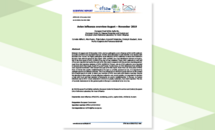Surveillance report: Avian influenza overview August – November 2019
This scientific report provides an overview of highly pathogenic avian influenza (HPAI) virus outbreaks detected in poultry, captive and wild birds and noteworthy outbreaks of low pathogenic avian influenza (LPAI) virus in poultry and captive birds, as well as human cases due to avian influenza (AI) virus, reported in and outside Europe between 16 August and 15 November 2019.
Executive Summary
Between 16 August and 15 November 2019, one low pathogenic avian influenza (LPAI) A(H5) outbreak in poultry in France was reported in Europe. Genetic characterisation reveals that the virus clusters with Eurasian LPAI viruses. No highly pathogenic avian influenza (HPAI) outbreaks in birds were notified in Europe in the relevant period for this report. HPAI A(H5N6) virus was identified in chickens in Nigeria, this is the first report of HPAI A(H5N6) from the African continent. Fewer HPAI outbreaks in Asia and Africa were reported during the time period for this report compared with the previous reporting period. Apart from the long-term epidemic of HPAI A(H5N2) in Taiwan, only six HPAI outbreaks were reported in domestic birds from Nepal, South Africa and Taiwan. Furthermore, no HPAI detections from wild birds were reported worldwide in the relevant time period for this report. Even if the risk of incursion of HPAI from wild birds into poultry establishments in Europe is currently assessed as low, it is important to maintain passive surveillance activities. The focus should be on wild bird species that are in the revised list of target species in order to detect any incursion of HPAI virus early and initiate a warning. Despite the decrease in the number of avian influenza outbreaks over recent months, it is important to maintain a high alert level and high standard of biosecurity on poultry establishments. In Europe, no human infections due to HPAI viruses detected in wild bird or poultry outbreaks, have been reported. The risk of zoonotic transmission to the general public in Europe is considered to be very low.
Download






